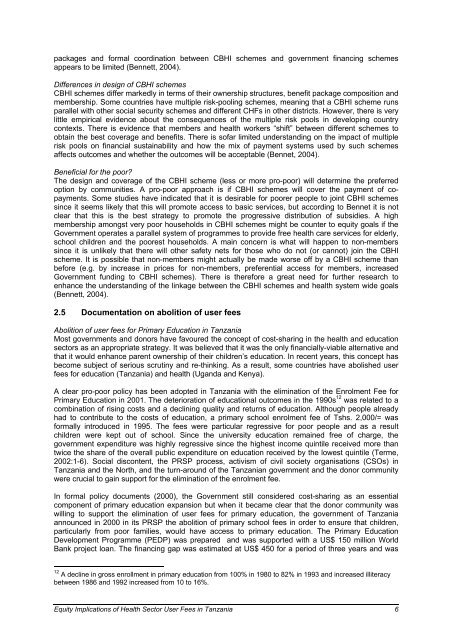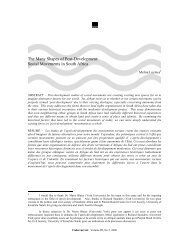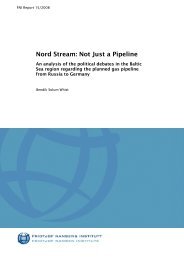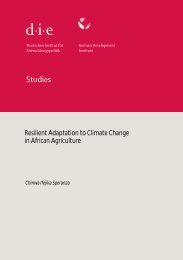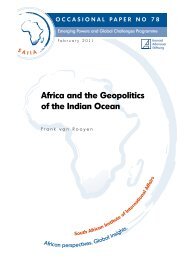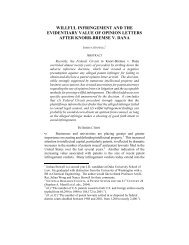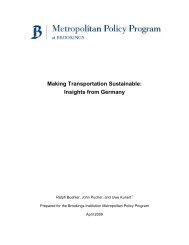equity implications of health sector user fees in tanzania
equity implications of health sector user fees in tanzania
equity implications of health sector user fees in tanzania
Create successful ePaper yourself
Turn your PDF publications into a flip-book with our unique Google optimized e-Paper software.
packages and formal coord<strong>in</strong>ation between CBHI schemes and government f<strong>in</strong>anc<strong>in</strong>g schemes<br />
appears to be limited (Bennett, 2004).<br />
Differences <strong>in</strong> design <strong>of</strong> CBHI schemes<br />
CBHI schemes differ markedly <strong>in</strong> terms <strong>of</strong> their ownership structures, benefit package composition and<br />
membership. Some countries have multiple risk-pool<strong>in</strong>g schemes, mean<strong>in</strong>g that a CBHI scheme runs<br />
parallel with other social security schemes and different CHFs <strong>in</strong> other districts. However, there is very<br />
little empirical evidence about the consequences <strong>of</strong> the multiple risk pools <strong>in</strong> develop<strong>in</strong>g country<br />
contexts. There is evidence that members and <strong>health</strong> workers “shift” between different schemes to<br />
obta<strong>in</strong> the best coverage and benefits. There is s<strong>of</strong>ar limited understand<strong>in</strong>g on the impact <strong>of</strong> multiple<br />
risk pools on f<strong>in</strong>ancial susta<strong>in</strong>ability and how the mix <strong>of</strong> payment systems used by such schemes<br />
affects outcomes and whether the outcomes will be acceptable (Bennet, 2004).<br />
Beneficial for the poor?<br />
The design and coverage <strong>of</strong> the CBHI scheme (less or more pro-poor) will determ<strong>in</strong>e the preferred<br />
option by communities. A pro-poor approach is if CBHI schemes will cover the payment <strong>of</strong> copayments.<br />
Some studies have <strong>in</strong>dicated that it is desirable for poorer people to jo<strong>in</strong>t CBHI schemes<br />
s<strong>in</strong>ce it seems likely that this will promote access to basic services, but accord<strong>in</strong>g to Bennet it is not<br />
clear that this is the best strategy to promote the progressive distribution <strong>of</strong> subsidies. A high<br />
membership amongst very poor households <strong>in</strong> CBHI schemes might be counter to <strong>equity</strong> goals if the<br />
Government operates a parallel system <strong>of</strong> programmes to provide free <strong>health</strong> care services for elderly,<br />
school children and the poorest households. A ma<strong>in</strong> concern is what will happen to non-members<br />
s<strong>in</strong>ce it is unlikely that there will other safety nets for those who do not (or cannot) jo<strong>in</strong> the CBHI<br />
scheme. It is possible that non-members might actually be made worse <strong>of</strong>f by a CBHI scheme than<br />
before (e.g. by <strong>in</strong>crease <strong>in</strong> prices for non-members, preferential access for members, <strong>in</strong>creased<br />
Government fund<strong>in</strong>g to CBHI schemes). There is therefore a great need for further research to<br />
enhance the understand<strong>in</strong>g <strong>of</strong> the l<strong>in</strong>kage between the CBHI schemes and <strong>health</strong> system wide goals<br />
(Bennett, 2004).<br />
2.5 Documentation on abolition <strong>of</strong> <strong>user</strong> <strong>fees</strong><br />
Abolition <strong>of</strong> <strong>user</strong> <strong>fees</strong> for Primary Education <strong>in</strong> Tanzania<br />
Most governments and donors have favoured the concept <strong>of</strong> cost-shar<strong>in</strong>g <strong>in</strong> the <strong>health</strong> and education<br />
<strong>sector</strong>s as an appropriate strategy. It was believed that it was the only f<strong>in</strong>ancially-viable alternative and<br />
that it would enhance parent ownership <strong>of</strong> their children’s education. In recent years, this concept has<br />
become subject <strong>of</strong> serious scrut<strong>in</strong>y and re-th<strong>in</strong>k<strong>in</strong>g. As a result, some countries have abolished <strong>user</strong><br />
<strong>fees</strong> for education (Tanzania) and <strong>health</strong> (Uganda and Kenya).<br />
A clear pro-poor policy has been adopted <strong>in</strong> Tanzania with the elim<strong>in</strong>ation <strong>of</strong> the Enrolment Fee for<br />
Primary Education <strong>in</strong> 2001. The deterioration <strong>of</strong> educational outcomes <strong>in</strong> the 1990s 12 was related to a<br />
comb<strong>in</strong>ation <strong>of</strong> ris<strong>in</strong>g costs and a decl<strong>in</strong><strong>in</strong>g quality and returns <strong>of</strong> education. Although people already<br />
had to contribute to the costs <strong>of</strong> education, a primary school enrolment fee <strong>of</strong> Tshs. 2,000/= was<br />
formally <strong>in</strong>troduced <strong>in</strong> 1995. The <strong>fees</strong> were particular regressive for poor people and as a result<br />
children were kept out <strong>of</strong> school. S<strong>in</strong>ce the university education rema<strong>in</strong>ed free <strong>of</strong> charge, the<br />
government expenditure was highly regressive s<strong>in</strong>ce the highest <strong>in</strong>come qu<strong>in</strong>tile received more than<br />
twice the share <strong>of</strong> the overall public expenditure on education received by the lowest qu<strong>in</strong>tile (Terme,<br />
2002:1-6). Social discontent, the PRSP process, activism <strong>of</strong> civil society organisations (CSOs) <strong>in</strong><br />
Tanzania and the North, and the turn-around <strong>of</strong> the Tanzanian government and the donor community<br />
were crucial to ga<strong>in</strong> support for the elim<strong>in</strong>ation <strong>of</strong> the enrolment fee.<br />
In formal policy documents (2000), the Government still considered cost-shar<strong>in</strong>g as an essential<br />
component <strong>of</strong> primary education expansion but when it became clear that the donor community was<br />
will<strong>in</strong>g to support the elim<strong>in</strong>ation <strong>of</strong> <strong>user</strong> <strong>fees</strong> for primary education, the government <strong>of</strong> Tanzania<br />
announced <strong>in</strong> 2000 <strong>in</strong> its PRSP the abolition <strong>of</strong> primary school <strong>fees</strong> <strong>in</strong> order to ensure that children,<br />
particularly from poor families, would have access to primary education. The Primary Education<br />
Development Programme (PEDP) was prepared and was supported with a US$ 150 million World<br />
Bank project loan. The f<strong>in</strong>anc<strong>in</strong>g gap was estimated at US$ 450 for a period <strong>of</strong> three years and was<br />
12 A decl<strong>in</strong>e <strong>in</strong> gross enrollment <strong>in</strong> primary education from 100% <strong>in</strong> 1980 to 82% <strong>in</strong> 1993 and <strong>in</strong>creased illiteracy<br />
between 1986 and 1992 <strong>in</strong>creased from 10 to 16%.<br />
Equity Implications <strong>of</strong> Health Sector User Fees <strong>in</strong> Tanzania 6


